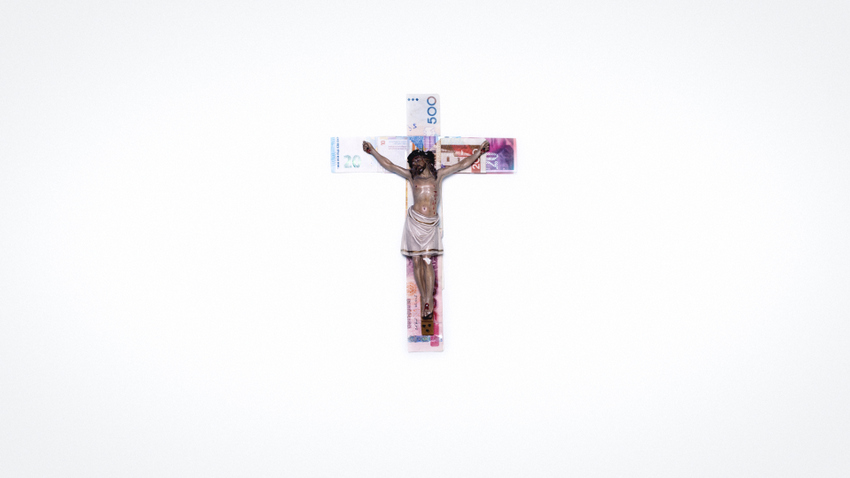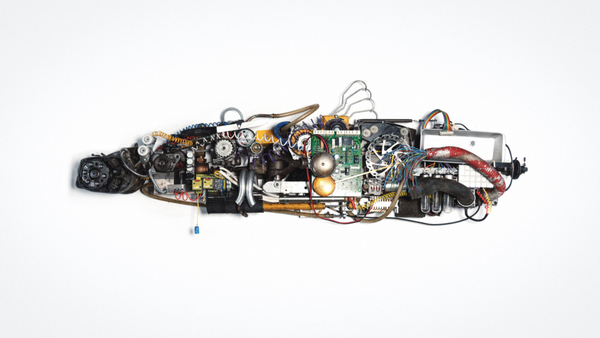
Q: Making a short film with a title that references being concise seems like an appropriate task, but you decided to make a film about existence. What was the impetus for this film?
I squeezed all the subjects, that somehow appeard important to me into it, took all the horsepower of the ridicolos speed and relentlessness of our zeitgeist, paared it with the unbelievable materialism of our world that allows me to talk about love, religion and sex by only putting objects on a plane white background and tried to tell a story with those ingredients.
The speed is so ridiculously high that it forces you to read in between the lines or rather see in between the frames. It is such an excessive amount of things, shown in such a short time, you are never able to perceive everything. I like to believe it’s ones subconscious that chooses what you see, hear and feel, depending on what is occupying your head and heart at the moment. No one has the same first In A Nutshell experience.
Q: What came first the visual style or the idea?
The project started originally as a trailer I directed for the International Film Festival Winterthur. I tried to make something eclectic. Creating a plot with objects that are involved in filmmaking. The trailer was 45 seconds long, but I felt that there was a story beyond. Could I capture the whole world in five minutes? I wanted to make an experimental film that has a narrativ. That is entertaining, funny and transports a message all in one. So once the visual style was set, the challenge was to find the objects that would become the symbols I needed to talk about the subjects I wanted to address. I’m convinced that in animation film the story or the concept has to chose it’s style. Then the style can be implemented into the story and the two become one.
Q: Can you talk about your process for finding and choosing the items you filmed?
I first juggled with all the hundreds of topics I felt I mustn’t leave out. That was a long and difficult process, ideal for loosing orientation. What was my original purpose in this hole mess I put my self in? In film school I was told, if you can’t break your story down to two catch-phrases you are likely to fail. I took this as a challenge. Life is more complex then that.
Breaking it down from subjects to actual objects was a fruitful process that helped me find the right connections from one theme to the next. The colors and the shapes create the keyframes for your brain to wrap one thing into the next one. After all, I only put static pictures of two different objects after each other.

Q: Is Hugo Sanders a reference to someone?
Hugo Sanders is the main character of an old song by Mani Matter, the most important singer/songwriter from Switzerland. Hugo Sanders claims, if he gets elected he would do everything different.
But once he is part of the governement he delays his everything-changing speech again and again. Starts to change detail after detail until nothing is left of his discourse. He ends his governorship without having changed anything at all.
Unfortunately we live in a time where the Trumps and Bolsonaros of this world actually do change things once they are in power. But I like how a song written decades ago, reveals the anti-establishment politicians as liars.
Q: Can you walk me through your animation process?
– How long did it take to film? From the first idea to the final film it took about two years. The actual animation took about six month of one to two people working full-time. Not to forget. When the film is done, there comes another year or two of evaluation.
– Are you shooting everything in studio? Everything was shot at the Yk Animation Studios in Berne, Switzerland. Only the bomb, had such a massive size that we had to build it in a separate atelier. It took two full weeks for Joder von Rotz, the main animator and his helping hand Philipp Strahm to create that monster. The animation was done with the help of a little trick. The hole sequences is played in reverse. It was much easier to animate single parts by taking them apart then building it from scratch. So when the animation was done. The bomb was torn into pieces again.
– What is the script process like? Do you write a script or just storyboard? I had to do a storyboard at one point. But, that was mainly to give others an impression of where this will go. It felt absurd drawing items, when it was all about finding items. When we actually started with the production of the animation I only worked with language – and whats app. Whole scenes, that I before had described only by words to my team were animated in my absence and sent to my via phone for further (often not needed) inputs. Magic!
– Is there any improvisation on set? There was. The colorful patterns done with the fruits were all created straight forward at the animation table.
– How much is done in post versus in camera? Any movement was done by hand in front of the camera. There are two little special effects that were done in the post when the bomb is built and of course a lot of compositing was involved.
– Are there any funny anecdotes while filming? Obviously the animators wanted to try to eat the sandwich after the scene with the two pieces of bread was done. It was hardly geniessbar. But we did, as e reference serve quite funky sandwich-combinations at the film premieres apéro. Some of them were surprisingly tasty.
– What’s it like to animate organic materials vs. inorganic? To animate the organic parts like for example the fruits, was a nightmare. On the second day everything started to rot. If you wanted to move one fruit, all the others wobbled along.

Q: Pablo Nouvelle did an incredible job sound designing your film. All of the noises really make the film come alive. Did you work closely with Pablo and what was your goal for the sound design?
Oh, thank you! I am Pablo Nouvelle. It’s the artist name I use for my music project and also for the few sounddesign attempts I did so far.
What I love about sounddesign is how it gives you the possibility to draw a meta level that is not necessarily obvious. For example the people talking and screaming when the bread gets divided. Or the baby screaming in the scene with the toys.
In A Nutshell is all about rhythm. Once I started with the sounddesign, editing was easy. Suddenly the timing was completely obvious. It is basically a 5min song. Prolong a frame only for a tiny moment and you changed the focus, maid a point or landed a little joke.
I have to say, I underestimate the expense a bit. Only to do the bomb building justice on a auditory level took for ever.
Q: You completed this film in 2017, but I noticed a very Donald Trump looking figure at 03:30 in the film. Is this a direct reference?
Trump?! No way. When we were producing the film, election in the US were already running in full speed. The joke would have worked even if he wouldn’t have been elected. I’ld have been ok with that out come but they didn’t ask me.
Q: Watching your film now, it’s shocking to see so many issues that have only gotten worse, including the refugee and immigration crisis. Would you make any updates to your film or is it fine left alone?
Once a project is done I’m actually happy to leave it as it is. No need for Kanye Westish changement on something that is already released. I see it as a document of it’s times. That said, of course there are subject that are missing in the film, that I’ld include nowadays. Feminism for example didn’t get it’s deserved place in the Nut.
Q: If you wouldn’t mind elaborating on the meaning of the ending that would be really enlightening. I read showing the evolution and destruction of phone/digital technology at the end as the metaphor that we’ve managed to fit the entire world into a microchip (i.e. nutshell).
However, i’m curious if there’s a deeper reasoning to start with a nutshell and then move into organic materials (i.e. paper, hand drawn sketches, plants, fruit, veggies into the mechanical era, which brought excess and finally into modern technology.)
There is a chronological order in the beginning. Starting with a seed, that could also be seen as a seed of ideas. The birth of the human consciousness leading into the discovery of mathematics, languages, architecture and art. Then opposing nature to the mechanical Industrialization where mankind got decoupled from its work, it’s creation. But then all those inventions lead into 1945 where man is suddenly able to end mankind with nothing more then bad foreign politics and a few red buttons. It would have been the end of the film. So I had to find a way around it. What do we do facing apocalypse? Well, nothing. Mainly ignoring it. Caring more about our own profits and pleasures. Partying.
When it comes to the end (of the film, not the world, yet) here are several approaches of which I wouldn’t want to point one out to be right or wrong. To come back to the seed, which restarts after the credits, that embodies the circle of life. I believe in cycles rather then in growth. Endless growth is a dangerous illusion and a threat to this planet. I prefer the Idea, that when I die, I become the ground I stand on. Energy never gets lost. That’s physics. So a part of me might become a tree. Another part might become a mountain. This obviously transcends our consciousness. But all I know for sure is our human imagination is pretty limited.
On the other hand there is the computer chip, which leads to a hole other bunch of questions. Where will the digitalisation take us? Will it soon be possible to contain our consciousness on a chip when our bodies are overdue? Is the chip the new seed? Or will artificial intelligence take over human kind? Does Big Data mean the complete dissolution of the individual?
Q: What are you working on now?
I just recently moved to London to focus on my music project Pablo Nouvelle. After releasing my third album Wired last March I played about 35 shows in Switzerland and Europe. The next release end of January, will be a collection of Piano Pieces. The simplicity of composing pieces using only the piano has something honest to it. I wanted to draw a drastic contrast to this short-living world, drowning in hate and plastic. In a way it’s the antithesis to In A Nutshell. But also a follow up. Even the artwork – done by a fabulous animator called Andrea Schneider is a homage to In A Nutshell.
Where We Stay by Florence Bouvy to Screen at CIFF
Where We Stay | CIFF Selected Drama About Friends Hiding Unspoken Truths
This Place by V.T. Nayani: Two Women in Love for the First Time on VOD & DVD March 25
Freestyle Acquires “This Place” for March Release
Sonoma International Film Festival Wraps with Unforgettable Films, Culinary Cinema and Packed Pop-In Events
Sonoma International Film Festival Grand Jury and Audience Award Films Announced
Livestreams with Grandmapuzzles by Emily Sheskin to Screen at CIFF
CIFF Selected Documentary About Twitch Streaming Jigsaw Puzzler
VisionRey Snags Acceptance for 2 Films at FilmApalooza
VisionRey is a Mexican-American Female-Led Film Company
Pomegranate by Weam Namou: on VOD Platforms and DVD on March 4
Freestyle Acquires Dramedy “Pomegranate” for March Release
Into The Spotlight by Thaddeus D. Matula: on VOD and DVD February 21
Freestyle Acquires Doc “Into the Spotlight”









